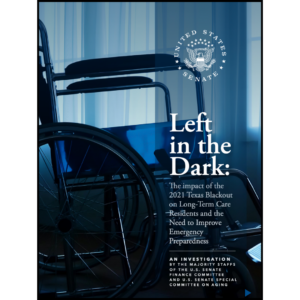How to cut LTC transportation costs
All LTC administrators are interested in reducing costs where possible. Transportation is one area that might be better managed to save money. True, there’s not much one can do about fuel prices or costly regulations pertaining to emissions standards, but transportation can be honed to operate more efficiently and less expensively.
According to Halsey King, a fleet transportation expert and principal at Halsey King & Associates, “The single biggest mistake we see today is failing to protect their investment.” (That is, the facility’s paratransit buses or vans.) He explains that choosing the wrong technician can compound maintenance and repair costs exponentially.
“Your mechanic at the local garage might be very good at his job, but unqualified to work on highly specialized paratransit buses or vans,” King says. Ever-changing technologies associated with these vehicles, such as new ramp or electronic systems add to the challenge. Ask the dealer who sold the vehicle for references and question your technician “to make sure he has experience with every system your bus has,” King says.
SUBCONTRACTING OPTION
Senior housing communities subcontract many things: foodservice, housekeeping, security and linen services, to name a few. So why do so many choose to manage their transportation programs themselves?
![]() “If your core competency is patient care or adult care, not transportation, doesn’t it make sense to subcontract it?” says Joe Rubino of J.M. Rubino Transit Consulting. “There is a big misconception that because everyone knows how to drive, it is possible to run a transportation operation well. In reality, it’s very complicated.”
“If your core competency is patient care or adult care, not transportation, doesn’t it make sense to subcontract it?” says Joe Rubino of J.M. Rubino Transit Consulting. “There is a big misconception that because everyone knows how to drive, it is possible to run a transportation operation well. In reality, it’s very complicated.”
While operations get to keep their own vehicles and even their existing drivers, the day-to-day responsibilities fall on the shoulders of the management company. “A contractor can simply manage it more effectively,” Rubino explains, and can help the facility get more for their expenses, such as payroll and fuel costs. They do so by utilizing economies of scale, specialized software and experienced coordinators and dispatchers.
“Be honest about how much you spend on transportation, and a management company will probably work with you to come up with a price that is lower,” Rubino says. “Sometimes the facility finds that just [the relief from] the hassles of fueling, maintenance and insurance make contracting a desirable option.”
GREENER ISN’T CHEAPER
While CNG (compressed natural gas) and gas-electric vehicles are being touted as the wave of the future, they are expensive to buy and own. A CNG system can add up to $20,000 to the cost of a vehicle. Commercial gas-electric vehicles, in addition to their unresolved safety concerns, feature not one, but two costly power systems and are still too new to offer any economies of scale. “There are too many issues with the technology at this point,” says King of the gas-electric options. "If you’re looking simply at fuel cost, nothing beats the economies of a diesel engine—not yet, anyway,” adding, however, “Twenty years from now, they’ll be commonplace.”
USE COMMUNITY SERVICES
While having one’s own buses and vans might be the ultimate in convenience for residents and operators, maintaining such a fleet can be costly. For operators that find it prohibitive to own their own vehicles, alternatives exist, and with investigation and coordination, using these alternatives can get residents where they need to go.
Elaine Wells, executive director of Ride Connection, encourages senior living communities to use their vehicles. Like similar programs around the country, Ride Connection receives federal 5310 funding (for the acquisition of vehicles for older adults) and requires a local match of just 20 percent from the nonprofit agency receiving the grant. Communities can contribute to the 20 percent match and have access to the vehicle. “They [the LTC communities] schedule with our dispatch center and we work around them, and they furnish their own drivers. We allow them to put their own sign on the bus when they are using it. It can be parked at our facility or theirs,” says Wells.
She explains that such vehicle-sharing is a good alternative for companies experiencing financial difficulties. When the parent corporation of a local senior living community entered bankruptcy recently, “they just used [the vehicle] less,” says Elaine. “Then, once the company stabilized again, they used it more. It works very well for some situations.”
PAYING FOR TRANSPORTATION
Did you know that you can actually use your bus or van to make money for your facility? Many newer vehicles offer drop-down LCD screens (or, you can have them installed on an older vehicle) on which your facility can provide entertainment content for your riders and sell advertising space to companies (such as pharmaceutical companies) whose target market includes LTC residents. Digital signage software companies help to provide the content and launch such initiatives to offset the cost of your new vehicle.
Finally, senior living bus and van owners should keep in mind basic cost- and fuel-saving measures. “Be smart about routing and work harder to combine trips and coordinate more intelligently to cut down on mileage and the fuel and maintenance costs that go with those extra miles,” advises King. And teach drivers fuel-saving measures, too, such as keeping the windows up and refraining from idling for long periods. Although they seem inconsequential, such common sense practices will result in accumulated savings over the long haul.
Gina LaVecchia Ragone is a freelance writer based in Cleveland.
I Advance Senior Care is the industry-leading source for practical, in-depth, business-building, and resident care information for owners, executives, administrators, and directors of nursing at assisted living communities, skilled nursing facilities, post-acute facilities, and continuing care retirement communities. The I Advance Senior Care editorial team and industry experts provide market analysis, strategic direction, policy commentary, clinical best-practices, business management, and technology breakthroughs.
I Advance Senior Care is part of the Institute for the Advancement of Senior Care and published by Plain-English Health Care.
Related Articles
Topics: Articles , Facility management , Operations











